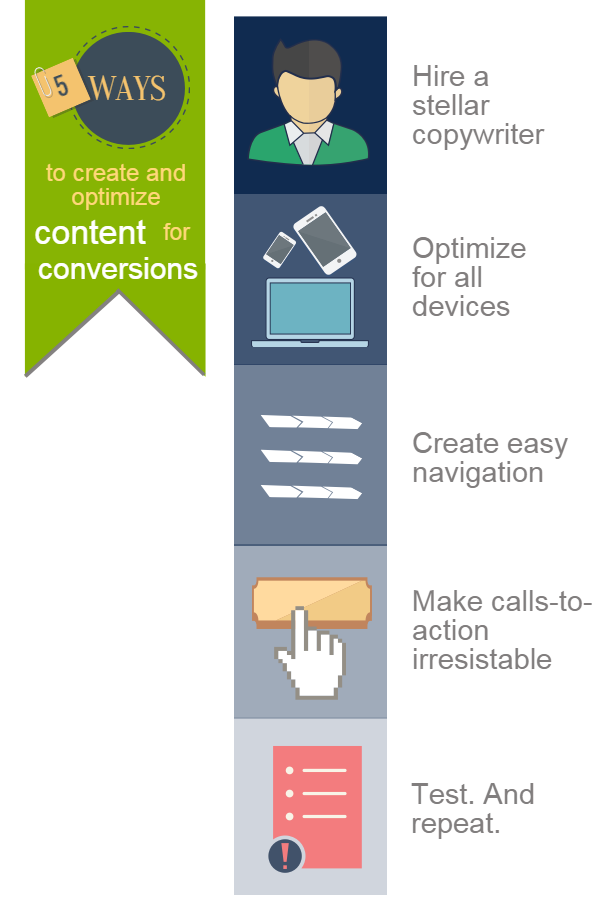Just as the sun doesn’t revolve around the earth, the Internet doesn’t revolve around your website. (Tough news to hear, I know.)
But as many B2B marketers are learning, there are ways to make your website more visible, generate more leads, inspire more to action and increase your conversion rate.
Web Conversion Optimization is the key. It’s also the umbrella topic for our blog series, and situated underneath it is web content. Content is the second ingredient in the “secret sauce” of web conversion optimization.
From this second blog post in our series, you’ll learn how content shapes, and consequently, is dramatically boosted by conversion rate optimization.
Q4: What type of web content helps boost conversion rates?
All content on a site must be created, curated and optimized toward conversions. We’re talking calls-to-action, testimonials, body copy, images–-all types of content on a website.
How do you optimize all types of content? Five ways to create and optimize content for conversions:
- Hire stellar copywriters. When it comes to content, nailing the message is critical. And the message should not change across channels. People are still people, regardless of the touchpoint
- Optimize for all devices. If content doesn’t fit properly on a user’s screen, within three seconds they’ll have moved on.
- Create easy navigation. User-friendly navigation means providing a clear path for the user to find the information they need. Also consider adding images and graphics (low-res where possible) for those who like to skim sites.
- Make calls-to-action irresistible. This is where conversions happen— when they follow through on your call to action (CTA). Don’t beg and plead, but don’t make the CTA tiny and easy to miss. Make it natural as the next step and so worth users’ time!
- Test, test, test. Testing should include A/B testing and cross-platform testing. By testing you are taking the guesswork out of web conversion optimization and instead allowing data gleaned from your tests to guide your decisions.
In all five of these suggestions, the main focus is still to serve users, not sell products.
Michelin Truck Tires has a new website optimized for conversions. Every online tool— from the dealer locator to the fuel & mileage calculator— is easy to find and was created expressly with Michelin Truck’s users in mind. The site also has a strong conversion rate as truck operators/drivers can quickly sign up for Michelin’s tire care program from any device.
(In our Twitter chat, this question led into four additional questions about content and web conversation optimization. Read on!)
Will optimizing web content also help lower bounce rates?
If content is carefully created to serve users—which does take research—it should reduce bounce rates.
How? In a perfect world, the content users find as they land on your site meets the criteria of exactly what they were searching for. Those landing pages should be your main conversion pages.
If you create content that serves users (and not necessarily search engines) and include keywords in headings and lists in bullets, etc., you will lower your bounce rates.
We could also get into how much content should be gated, or if any should be gated at all. If your bounce rates are high, try shortening or removing the form fields on your landing page.
One more tip on lowering bounce rates: don’t make users think! According to a study by Neilson Norman Group, 79% of test users scanned any new webpage they came across; only 16% read word-for-word. You will lose visitors if you make your content hard to skim or bury valuable content deep within the feeder pages of your website.
What type of investment in time does it take to ensure you keep content up-to-date/optimized?
That’s a great question. Depending on your organization and size of the website itself, that could be a few hours per week or a full-time position. Marketers are realizing more and more that content development takes time and money, but it’s worth it for both the sales and marketing teams.
Keeping your website optimized is like getting your oil changed so your car runs at its peak performance or cleaning your house so your family can function at its best. Sound investments in the long run.
Is content development all there is to optimizing your website?
Not really. Optimization covers a lot of things. It gets into deeply technical things like page load speeds and SEO as well. (We might suggest reviewing the first blog post in this series to learn all the ways you can perform web conversion optimization.)
In the end, it’s a holistic approach! And when we focus on providing the optimum experience for our users in every area, everybody wins.
Would you say that optimization includes commitment to content development?
Oh, absolutely! I love that you chose the word commitment, because that’s what it takes to see results in that area. One of the biggest things I stress with content development and publishing to clients is consistency! The most common misstep that marketers make when optimizing their websites is not taking a “content-first” approach.
One more point I need to make: I think it’s important that content be defined broadly. Not just what you say, but to whom, how and when you say it. For writing great content, you need to have a great understanding of buyer personnas.
The good news is that optimization leads to optimization. The more we engage our audience, the more we will learn about them. Smart marketers will gather and use the massive amounts of market intelligence they can gain through this effort. That is why optimization will lead to more optimization, and continually improve your site.
If your content is meeting the needs of your visitors and is optimized, you are in the game.
Quick review: in this web conversion optimization mini-series, we’ve learned that web conversion optimization’s secret sauce takes time (because it’s continual) and it takes content. Join us for the rest of the blog series to learn about web personalization and performance.









